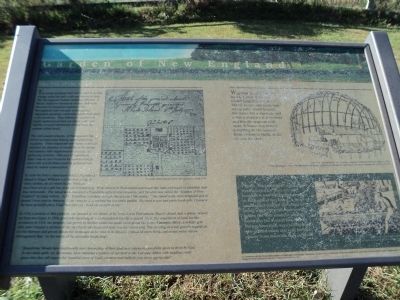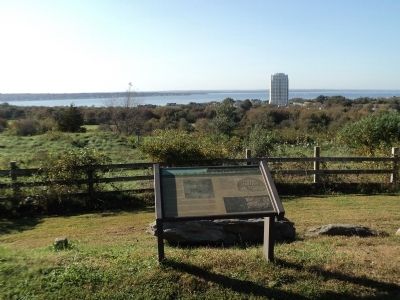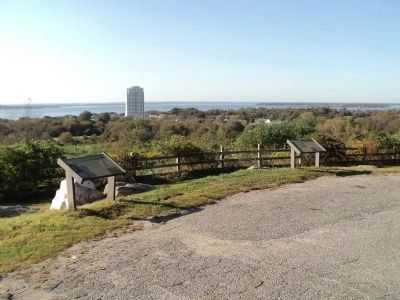Portsmouth in Newport County, Rhode Island — The American Northeast (New England)
Garden of New England
The Use of the Land
The scenic landscape that can be seen from this vantage point has had a rich and vibrant history. The Narragansett Indians inhabited this area of Rhode Island for thousands of years before its discovery by European explorers. The Narragansett tribe was part of the greater Algonquin-speaking community which flourished in the northeast. They followed a tradition of highly sophisticated land use where individual families received allotments of land from the sachem (tribal head).
The rich coastal estuaries of Narragansett Bay served as important fishing and shellfishing localities. Other important subsistence activities included the planting of cornfields in the spring and summer with supplemental hunting and gathering activities. This part of Aquidneck Island was the ideal location for seasonal camps where fish and shellfish could be gathered and salted for winter consumption.
In 1636 the Native Americans deeded Aquidneck to Roger Williams and the first group of white settlers, an act which Roger Williams described not as a sale but as an act of friendship. Soon settlers in Portsmouth purchased the land and began to establish their own farmsteads. The island soon sustained a flourishing agricultural economy, and the area was called the “Garden of New England” by many writers. A Dr. Hamilton, traveling through the area in 1744, wrote “The Island is the most delightful spot of ground I have seen in America. I can compare it to nothing but one entire garden. For rural scenes and pretty frank girls, I found it the most agreeable I had been thru (sic) in all my peregrinations.”
In 1912 a portion of this property was deeded to the Order of St. Benedict in Portsmouth, Rhode Island, and a private school for boys was begun in 1926, presently operating as a coeducational boarding school. Since the acquisition of land for the monastery in 1918, the property has grown by further additions made throughout the years. Carnegie Abbey, a private golf club now occupies a portion of the significant and beautiful land you see before you. The clearing of scrub growth vegetation for the fairways and greens allows the landscape to be seen in its historic context of open fields and scenic vistas across Narragansett Bay. In the words of the monastic leadership:
“Benedictine Monks have traditionally seen stewardship of their land as a serious responsibility given to them by God. In this same spirit, we, the monks, have entrusted a portion of our land to the Carnegie Abbey with steadfast confidence that they will respect this beautiful piece of God’s creation and make it even more spectacular.”
[ Sidebar : ]
Wigwams provided shelter for the Native Americans inhabiting Aquidneck Island. Native American men set up poles which became the frame for a wigwam, and it was a women’s task to cover and line the wigwam with mats. A home was moved according to the seasons, from valleys to fields, as the climate dictated.
Native Americans built canoes from trees selected for their size and breadth. A tree was burned slowly at its base and it was felled. A series of smaller fires charred the center of the trunk, which the craftsmen would hollow out with seashells until the canoe was the desired size and shape. Native Americans were skilled sailors who crafted masts and sails for their canoes from materials they gathered.
Topics. This historical marker is listed in this topic list: Native Americans. A significant historical year for this entry is 1636.
Location. 41° 36.673′ N, 71° 15.628′ W. Marker is in Portsmouth, Rhode Island, in Newport County. Marker is at the intersection of West Main Road (Rhode Island Route 114) and Anselmo Drive, on the right when traveling south on West Main Road. Marker is located in the Lehigh Hill Overlook. Touch for map. Marker is in this post office area: Portsmouth RI 02871, United States of America. Touch for directions.
Other nearby markers. At least 8 other markers are within 3 miles of this marker, measured as the crow flies. Battle of Rhode Island 1778 (here, next to this marker); Butts Hill Fort (approx. 0.6 miles
away); The 1st Rhode Island Regiment and the Battle of Rhode Island (approx. 0.7 miles away); Site of the Battle of Rhode Island (approx. 0.7 miles away); The Black Regiment (approx. 0.7 miles away); Portsmouth Compact (approx. 1.3 miles away); W 3 R (approx. 1˝ miles away); Mount Hope Bridge (approx. 2.4 miles away). Touch for a list and map of all markers in Portsmouth.
More about this marker. A sketch on the left side of the marker depicts the “Grounds about General Prescott’s Quarters, circa 1777.” The sidebar at the marker’s right contains pictures of a wigwam and Indians constructing a canoe.
Credits. This page was last revised on June 16, 2016. It was originally submitted on October 25, 2011, by Bill Coughlin of Woodland Park, New Jersey. This page has been viewed 865 times since then and 27 times this year. Photos: 1, 2, 3. submitted on October 25, 2011, by Bill Coughlin of Woodland Park, New Jersey.


